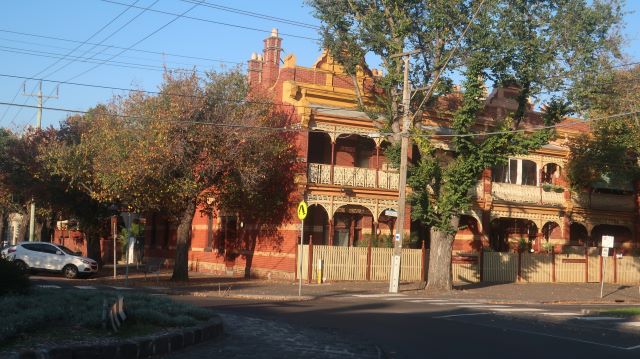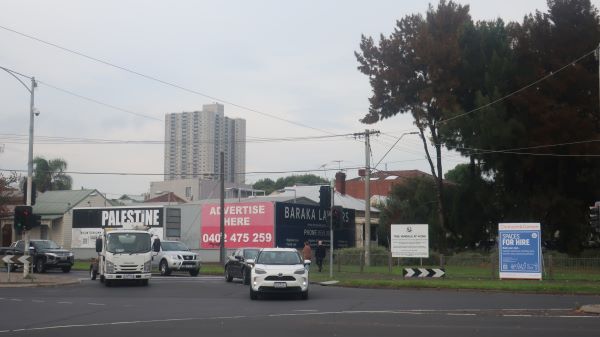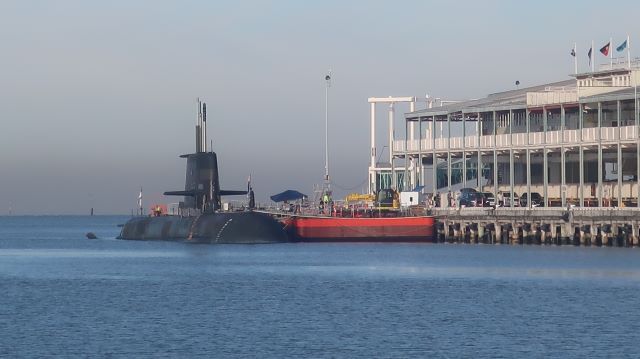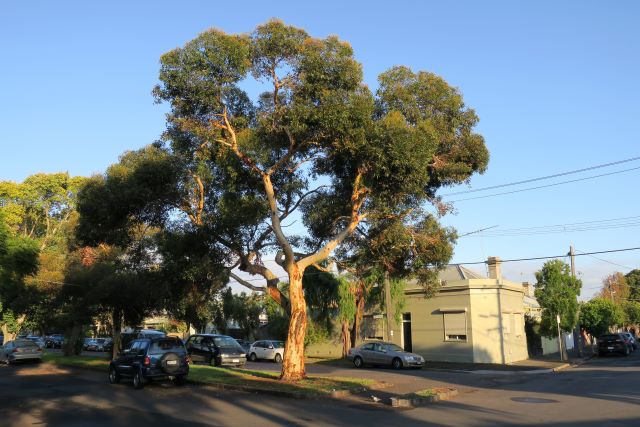
A tale of two Montague Streets
Returning home to Port via Montague St, it is likely you would have stopped at the traffic lights at City Road. It can feel like a long wait. A City of Port Phillip sign futilely warns that there are penalties for removing trees at this location. Advertisers ignore the notice when there is an of opportunity to put signs before the eyes of the thousands of motorists passing each day.
You can’t continue along Montague St.
The options are a right turn to Port Melbourne or a curve away to the left along York St.

The late Reg Macey, former Mayor and Councillor at the City of South Melbourne, invited me to walk here with him where he had walked with his grandmother as a boy. She seemed determined to pass on her stories, reaching back into the late 19th century, to him. ‘Look up, look down’, she exhorted him. He became an attentive observer of the urban scene.
Reg introduced me to his association with this intersection. The route for the F9 freeway proposed in the 1969 Melbourne Transportation Plan would have continued along Montague St, cutting through St Vincent Place and St Vincent Gardens.
At that time, many houses in St Vincent Place were boarding houses, still languishing in the long shadow of the 1890s depression. But young families were moving in and doing them up. They were becoming active in local politics. The Emerald Hill Association was one of several groups campaigning against the extension of freeways in the inner city.
As a result of the concerted campaign of all these groups, Rupert Hamer made it an election pledge in 1972 to abandon, and modify, some of the freeway routes. The incoming Whitlam Government declined federal funding for the freeways.
And that is why at City Rd, through traffic from Montague St deviates along York St before turning right into Ferrars and thence via St Kilda to St Kilda Road.
In 2013, Montague St between Normanby Rd and City Rd carried 20,445 vehicles in the southbound direction, according to a traffic study commissioned for Fishermans Bend. On the southern side of City Rd, Montague St is a quiet, pleasant local street.
Hard to believe it is the same Montague Street.
St Vincent Place retained its integrity. York St, with its older, but more modest houses, took the traffic load.
Emerald Hill for sale
In late 1973, Reg noticed ‘for sale’ signs appearing around the Emerald Hill estate. The estate, bounded by Cecil, Bank, Dorcas and Clarendon Sts was to be sold by international expression of interest on Thursday, December 6, 1973, by its owner, the Melbourne Family Care Organization. Known locally as ‘The Hill’, the area comprised 117 buildings, including 89 residences and 53 shops. It also involved nearly 300 residents and 60 shopkeepers, many of whom have lived and worked on ‘The Hill’ for generations.
Park Towers had recently been completed, opened in 1969 by by the Governor Rohan Delacombe. A whole block including houses, shops and hotels had been demolished to make way for it. At 31 storeys, it was the largest block to have been built by the Housing Commission.
There was growing disquiet about the scale and scope of the Housing Commission’s reach accompanied by a growing interest in protecting housing from the Victorian period.
Reg went from door to door conducting a survey of the residents of the Hill. He was concerned about the potential displacement of the community of Emerald Hill.
He led a campaign against the sale of the estate. It culminated in a procession around the Hill led by a town crier, with a hearse, proclaiming the death of Emerald Hill. The procession concluded on the steps of the South Melbourne Town Hall where every news channel around Australia covered the story. The sale was imminent.
At the eleventh hour, Tom Uren, then Minister for Urban and Regional Development in the Whitlam Government, made a federal loan facility available to the state government to enable them to buy the estate.
The campaigns of citizen activists like Reg Macey and Brian Carter, pioneer of the urban forest, have profoundly shaped the South Melbourne we know today.
To conclude with Reg Macey’s words: “The human aspect of urban planning has, for too long, been neglected in this country. The problems faced by those on ‘ The Hill’ are surely repeated countless as changing land use, freeway construction, market pressures, urban renewal and rezoning force others leave areas in which they have been long established.”
acknowledgements: conversations, emails and walks with the late Reg Macey (1936 to 2024)
2 Comments
-
Anne Garrow
Thank you Janet. It is good to be reminded of history and what shapes our neighbourhoods. Very interesting to read about Montague Street and Emerald Hill Estate.



Heather Wheat
So interesting Janet. . Reading this and the article on Brian Carter gives me more of an understanding of the passion I encountered in many of the residents when we first moved into Southbank and became engaged in local consultations and groups. The history is fascinating to me as a relative newcomer and fringe dweller (as a Southbanker). I look fwd to your next story.